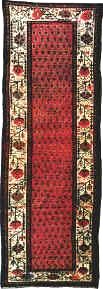|
|
Technically
Type of looms:
In urban regions, Tabrizi looms are used while in villages, some old local looms are in use. All looms in Hamadan and affiliated suburbs are vertical, except in tribal regions of Saveh and a few villages of Hamadan.
Finesse:
Urban type carpet-weaving has 27 to 35 veins in each knot for each 26 cm. while rustic carpets have a maximum of 25 veins.
Weft setting:
In Urban regions, carpets are usually double-weft but in rustic area are single-weft.
Dimensions:
In urban regions carpets are woven mostly 2*3, 2.5*3.5 meters and larger. In rustic districts, the most common sizes are 2 zar, 11/2 zar, 1/4 zar, poshti, kharak, runner, etc. Although some 2.5*3.5m. carpets may be woven.
Pattern of Texture:
In rustic style, the weaver usually works on a sample or by memory. In urban style, he works following a design on the paper, but still in some villages such as Darjazin of Kabutarahang and some villages of Hajilu and Chaharblok , nowadays paper design is in prevalence.
Type of excavation
In rustic regions, weaver provides raw material and capital at his (her) home workshop and the way of production depends on requirements, possibilities, financial power of weavers and even climatic and season alterations.
In urban regions, weavers are mostly as wage-earner and employees of employers. In centralized workshops and factories, weaver-worker owns nothing but his (her) manpower. Working-hour is decided by employer and production activity is more connected and drastic, follows rules and fluctuations of market.
Considering Manpower
There is no male weaver in the rustic regions. Carpet weaving is a job appropriated to women and girls, but in city of Hamadan still a quarter of weavers are men-laborers.

Runner: Paisely Design (Angelas)
|
|

